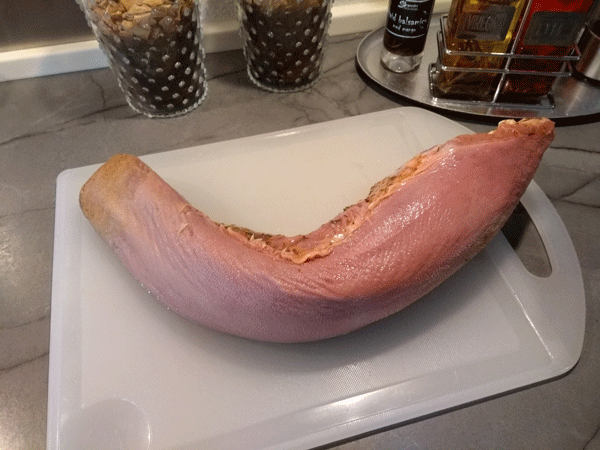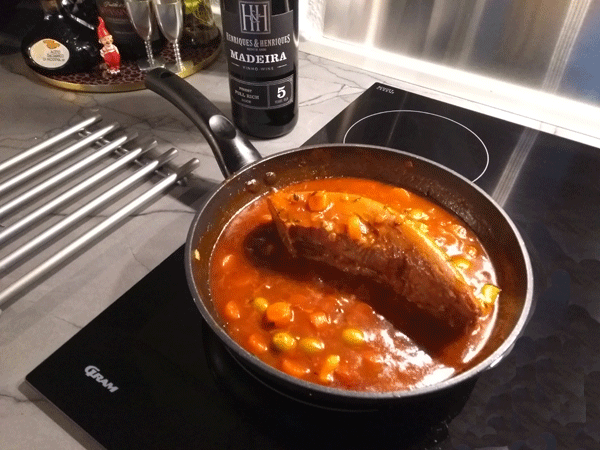Veal tongue in Madeira, beer and olives
Shopping List for 4 adults
|
1 veal tongue
Dry salting in a vacuum bag per 1 kg veal tongue 13 g Common table salt 13 g Nitrite salt 0.6% 7 g Cane sugar, Organic 2 g Black pepper, powder 1 g Cayenne pepper hot, powder 2 g Garlic powder 3 g Hungarian paprika, sweet 2 g *Dried thyme, see below 1 g *Laurel leaves, see below 1 Sodium ascorbate E301 Degree of salinity: 2.6% Max Nitrite: 80 mg/kg tongue Salting time in the fridge: 6 days Mix salt, sugar and all spices and rub the veal tongue well into this salt mixture. Put the tongue in a vacuum bag and make sure everything goes in the bag so that the salting percentage is maintained. Vacuum seal the bag and refrigerate for 6 days. The bag is turned daily.
I have created an Excel spreadsheet to calculate salt, nitrite salt, sugar and spices for any amount of meat and meat of any kind. But that's only for vacuum salting. If the weight of your calf's tongue is different, you can use this spreadsheet to your advantage. |
I am an angler in Scandinavia
Recipe No. 145
|
|
> Procedure without liability: A tongue is a large bundle of muscle, therefore it must now be boiled tender for a long time at low heat. Put the tongue in a suitably large pot and pour 2 liters of water. The water must cover the tongue completely, otherwise more water will come on. You can advantageously cook the tongue with fresh *thyme stalks and *bay leaves and a few carrots. The veal tongue is quickly brought to the boil and the heat is immediately reduced so that the veal tongue only simmers for the next 2 ½ hours. Skim the soup for impurities, as it will be used later. Meanwhile, prepare the good Madeira Sauce for the veal tongue.
Put olive oil in a pan and fry the onion, carrots and tomato puree in it for a few minutes. Add the garlic and a little Sherry vinegar. Bring to a boil then add the Madeira, KB beer, Tamarind Sauce, thyme, tarragon and dilute the sauce with soup until a suitable smooth consistency is achieved. Place the veal tongue in the middle of the pan and pour some sauce over it while the tongue is heated for 15 minutes on low heat. Flip the tongue a few times along the way. Pour the drained green olives into the sauce a few minutes before serving. Pick up the tongue and cut it into 6 to 8 mm thick slices crosswise.
NB: I just want to note that I have split the tongue, so I have cold tongue for cold cuts with horseradish salad or Italian salad. The thickest part is therefore not visible on the pan above. Serving: You can serve the tongue with many different kinds of side dishes: Rice, noodles, spaghetti, potatoes - boiled, mash, rösti, fritters - or my Böhmische semmel knödel Recipe No. 27. Side dishes, which are good at soaking up the tasty sauce, are preferable. We chose small, fine peeled potatoes this time. Next time I will prefer my Böhmische semmel knödel. Garnish: I can only think of fresh thyme sprigs, but I had already used mine in the dish. Drinking: You can drink beer or red wine with the dish. We chose an Italian red wine - Appassinero Appassimento da uve legmentere appassite - it is a red wine made from lightly dried grapes. Advantage: on offer for DKK 42.00 a bottle, Disadvantage: with added sulphites. Tip: If you want to try with tongues for other animals: Pig tongue must cook for 1 ½ hours, while a Veal tongue must cook for 2 ½ hours and a Beef tongue must cook for 3 ½ hours on low heat. Make your own Tamarind Sauce. |
Back to the page where you came from.

